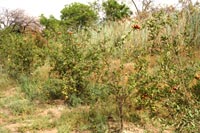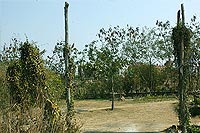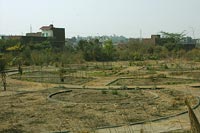
Yamuna Biodiversity Park
Conservatory of Fruit yielding species
The display of about 500 varieties of 80 species of fruit yielding plants in a small area reveals the astounding diversity found amongst fruiting plants. The conservatory harbours some unfamiliar fruits in addition to many familiar ones. Khirni – a locally extinct species is thriving as are anar, sapota, jamun, gauava, amla, lemons, oranges, grapes, loquat and ber. The conservatory is a home to variety of birds such as parakeets, yellow footed green pigeons, munias, babblers, coppersmith barbets, bulbuls and peafowl in large flocks, as also snakes which are rarely seen except between April and October.
Herbal Garden
The herbal garden, in essence, is a reference collection of around 450 living species that have been important in human culture throughout the ages. This garden is a green oasis with a diversity of medicinal plants. In between more than 200 seasonal changing beds and borders are trees with medicinal properties that provide shade to delicate plants. The Yamuna Biodiversity Park herbal garden is a charming place to visit any time of the year. Spring brings exuberance and the full bloom of Barlerias, summer the flowering of the Hibiscus, the monsoon Ocimum and Costus and winter a profusion of Andrographis, Bacopa, Calendula, Aloe, and Tylophora. A total of 434 species including 120 species of trees, 280 species of shrubs and herbs, 26 species of climbers and 8 species of grasses have been planted. The Cerulean butterfly flutters over the beds of Spilanthes acmella and frequent bird sightings are those of the hoopoe, the green bee eater, and doves.
Butterfly Conservatory
The Yamuna Biodiversity Park aims to create a Butterfly Conservatory, that will become a major ecotourism destination for visitors and nature lovers. There are four small ponds to add humidity to the surroundings and provide moisture to the butterflies. The Plantation of native plants will attract thousands of wild butterflies, who play important roles as pollinators, as part of the web of life and as cultural icons for human beings. Within beds of butterfly attracting plants are trees that have been landscaped to resemble mixed deciduous forest communities. Unlike birds, butterflies are late risers and can be seen in large numbers late in the morning. Their population peaks in spring but they remain in plenty right up to the monsoon. Presently, as many as 36 species of butterflies and their caterpillars can be sighted here.
Stroll through the beautifully designed butterfly conservatory; watch the blossoming of new life in a nearby zone of larval host plants and sericulture and admire flittering of tasar silk moth. The “butterfly observation shed” made of bamboo is a quiet place to sit and observe these beautiful insects at work on plants like Thevetia and Milkweed.





